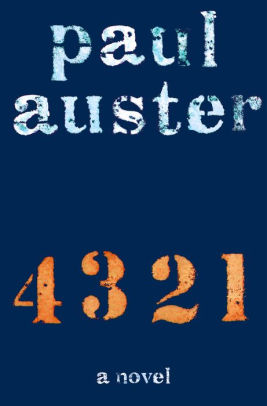
It’s been a while since I’ve read any of Paul Auster’s novels, but I remember enjoying the ones I read. So when 4 3 2 1 ended up in my stack of novels to judge in the Group Stage of The Mako Prize, I was excited. It’s a daunting book because of its length. It’s 866 pages, but it also has fairly small print, so it’s easily over 1000 pages in a more typical font size.
The premise is fascinating. The book is asking the question, What if … What if one decision we make in life were made another way? What if we turned left instead of right, chose this over that? What if some factor out of our control had been different?
Auster takes that question and plays out literal answers to it, telling four different versions of the same character’s life. But he’s not telling them sequentially, but instead cycles through the four of them almost simultaneously, in seven sections. In each section, he looks at the four different versions of Archibald Isaac Ferguson’s life.
The first chapter (1.0) tells the brief story of Ferguson’s ancestors, up until his birth. Then each of the seven cycles has four parts, one for each iteration of Ferguson’s character (1.1, 1.2, 1.3, 1.4, etc.)
For the first several hundred pages I was sold. Up until the point where Ferguson goes off to college, it’s an interesting set of windows on the boy’s youth and high school years.
But the second half of the book changes character for me so dramatically that I became totally frustrated with it. Auster says the novel is not autobiographical, and that’s partly true. Ferguson isn’t Auster; his family isn’t Auster’s family. But claiming it’s not autobiographical is disingenuous. Once Ferguson goes off to college (either at Columbia or Princeton), the novel almost ceases to be about Ferguson at all and it becomes Auster’s post-mortem on 1960s history, culture, and the revolution at Columbia.
Auster was at Columbia in the 1960s. A number of the characters in the novel are actual people, his friends from his college days. He was involved in the protests and occupied one of the buildings on campus. The stuff in the novel is the stuff they did. If you ask me, it would be hard to be any MORE autobiographical.
And what’s worse is that during this part of the novel, it is impossible for me to care about most of the characters any more because they became monumental assholes–pretentious, self-righteous hypocrites. The part of the book that made me care about the versions of Ferguson was gone. The second part is Auster’s chance to relive his glory days at Columbia, perhaps, but the story gets sacrificed for the sake of retelling that history.
No one needs 866 densely-packed pages of that. It takes nearly a week’s full-time work to read this one. Or you could read three other novels that you’ll enjoy more.
The premise is fascinating. The book is asking the question, What if … What if one decision we make in life were made another way? What if we turned left instead of right, chose this over that? What if some factor out of our control had been different?
Auster takes that question and plays out literal answers to it, telling four different versions of the same character’s life. But he’s not telling them sequentially, but instead cycles through the four of them almost simultaneously, in seven sections. In each section, he looks at the four different versions of Archibald Isaac Ferguson’s life.
The first chapter (1.0) tells the brief story of Ferguson’s ancestors, up until his birth. Then each of the seven cycles has four parts, one for each iteration of Ferguson’s character (1.1, 1.2, 1.3, 1.4, etc.)
For the first several hundred pages I was sold. Up until the point where Ferguson goes off to college, it’s an interesting set of windows on the boy’s youth and high school years.
But the second half of the book changes character for me so dramatically that I became totally frustrated with it. Auster says the novel is not autobiographical, and that’s partly true. Ferguson isn’t Auster; his family isn’t Auster’s family. But claiming it’s not autobiographical is disingenuous. Once Ferguson goes off to college (either at Columbia or Princeton), the novel almost ceases to be about Ferguson at all and it becomes Auster’s post-mortem on 1960s history, culture, and the revolution at Columbia.
Auster was at Columbia in the 1960s. A number of the characters in the novel are actual people, his friends from his college days. He was involved in the protests and occupied one of the buildings on campus. The stuff in the novel is the stuff they did. If you ask me, it would be hard to be any MORE autobiographical.
And what’s worse is that during this part of the novel, it is impossible for me to care about most of the characters any more because they became monumental assholes–pretentious, self-righteous hypocrites. The part of the book that made me care about the versions of Ferguson was gone. The second part is Auster’s chance to relive his glory days at Columbia, perhaps, but the story gets sacrificed for the sake of retelling that history.
No one needs 866 densely-packed pages of that. It takes nearly a week’s full-time work to read this one. Or you could read three other novels that you’ll enjoy more.
 RSS Feed
RSS Feed
